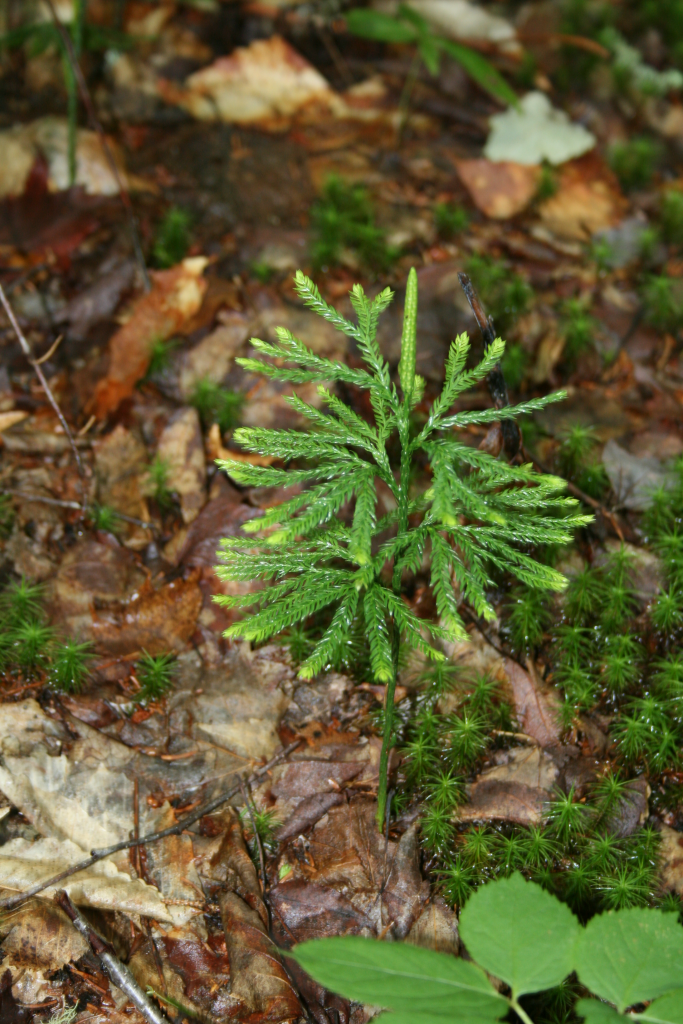Clubmosses: Lycopodium

Clubmosses are representatives of the Lycopodiophyta, plants that are very important in the fossil record and in the history of plant life but are not particularly diverse or common now. World-wide there are around 1000 species in the group. As is the case with many of the ferns, the common names for clubmosses have been much more stable than the scientific names, several of which have been changed in the last thirty years. Several species are frequently encountered in the understory forests of the Adirondacks of New York and in forests in New England. All members of the group that exist today are small plants, typically less than 10 cm in height. But in the past members of the group were much larger and formed forests. The group originated over 400 million years ago in the Paleozoic and the phylum is the oldest group of vascular plants that still has members today. Tree forms up to 35 m in height were common at the end of the Paleozoic, roughly 300 million years ago, and were important in forming deposits that are sources of coal and oil. All the tree forms disappeared at the end of the Paleozoic.
Taxonomy and Phylogeny
The clubmosses form a distinct group that is generally recognized at the phylum level (Lycopodiophyta). They are one of the groups of ‘fern allies’, groups unified by having vascu lar tissue but lacking seeds. The other groups are the ferns, horsetails and wisk ferns (some people lump these three groups together into one phylum). Although ferns and clubmosses can be linked by what they do not have (seeds) this is not a good criterion for forming a group and for this reason, and many others, ferns and clubmosses are NOT thought to be phylogenetically close, so the ‘fern allies’ are not grouped together. The Lycopodiophyta includes three groups, clubmosses, spikemosses and quillworts.
Structure
As the name implies, clubmoss sporophytes (the spore producing form) look like mosses but they are generally bigger, reflecting the fact that they have vascular tissue, and they often have ‘clubs’ or strobili, structures where spores are produced. The plants have the typical plant structure of an elongating axis that bears flaps of tissue, ‘leaves’ that possess on a single strand of vascular tissue. Clubmoss leaves are called ‘microphylls’ to distinguish them from true leaves (‘megaphylls’) that have more extensive venation. On some clubmoss and spikemoss species the leaves are overlapping and resemble those of cedar, which gives some species a common name of ground cedar. Most species produce above and/or below ground stems that run horizontally and send up vertically oriented branches. The gamete producing plant is often small, often only a few mm in size, rarely over a cm in size, and has an amorphous structure that produces small egg-producing archegonia and sperm producing antheridia.

Reproduction
Like all plants, clubmosses exhibit alternation of generations. The group has a relatively large sporophyte and hard-to-find gametophyte that is small, uncommon and subterranean. The gametophyte depends upon an association with fungi to obtain carbohydrates. Gametophytes are bisexual and the flagellated sperm swims to the to the structures, the arechegonia, that produce eggs, Other groups within the Lycopodiophyta (Selaginella = spikemosses, Isoetes = quillworts) are heterosporous and some members, both living and fossil, produce structures approaching seeds, having megaspores are retained on the sporophyte and also a female gametophyte that develops endosporically (see Chapter 13).
Matter and energy
T he clubmoss sporophyte is a typical photoautotroph, using the energy of sunlight to synthesize carbohydrates from carbon dioxide and then using the carbohydrates as an energy source in cellular respiration and as building materials to synthesize a variety of biomolecules. The gametophyte is a heterotroph, a parasite on fungi (mycotroph), that obtains matter and energy from a fungus that it associates with.
Interactions
Although clubmosses a re common in northern hardwood forests, they are not particularly important. They are not obviously eaten by common herbivores, perhaps because of their chemistry, which contains alkaloids. Historically, the spores were used as an early form of photography ‘flash powder’ as they can ignite explosively. The spores were also used as a type of lubricating body powder.
Further Reading and Viewing
- “Clubmosses: An Ancient and Interesting Group of ‘Fern Allies'” by Marion Lobstein
Media Attributions
- Clubmoss © Bernd Haynold is licensed under a CC BY-SA (Attribution ShareAlike) license

